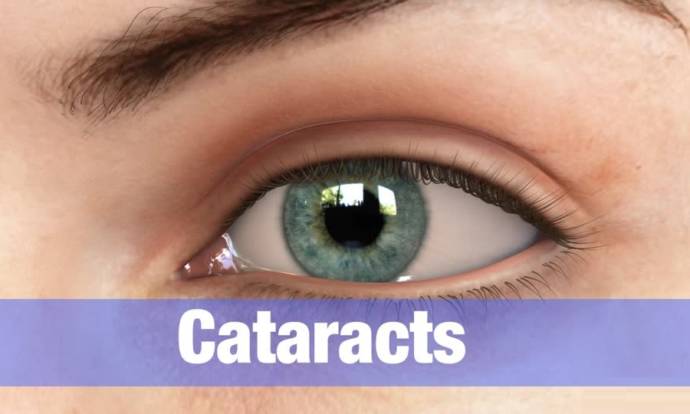There is a clear lens present in the eye which assists in vision. With age or other causes, the lens gets opaque leading to cloudy vision. This condition of an opaque lens is known as a cataract. Symptoms of cataract include cloudy vision, sensitivity to bright light, poor night vision and halos around the light. Diagnosis is done through a slit lamp, acuity test and retinal examination.
Types
Based on the location of the opacity in the lens of the eye, a cataract can be divided into three types. These are the age-related cataract, which occurs after a particular age in the patient. One type or the combination of types of cataract may be found in the patient suffering from cataract. Following are the three types:
- Cortical cataract: This type of cataract starts from the periphery or outer surface of the lens and gradually moves towards the center in a spoke fashion. This type of cataract occurs due to the damage in mature fiber cells.
- Posterior subcapsular cataract: This type of cataract id found in the posterior or back surface of the lens. The patient experiences sensitivity to light, the problem in reading, glare, and reduction in vision in bright light. This cataract is seen at a younger age as compared to the other two types of cataract. This type of cataract is generally seen in the patients suffering from diabetes and patient undergoing chronic treatment with steroids.
- Nuclear sclerotic cataract: Nuclear means the center portion while sclerosis means hardening. Thus, in context to cataract, this type of cataract causes opacity in the central part of the lens. This is the most common type of cataract found at an older age.
Causes
Following are the causes of cataract:
- Age
- Diseases such as hypertension and diabetes
- Eye injuries
- Long term steroid administration
- History of ophthalmic surgery
- Smoking, obesity and drinking alcohol
- Extreme exposure to sunlight
Symptoms
- Cloudy vision
- Poor vision in dim light
- Sensitivity to bright light
- Halos around light
- Changes in eyeglass number
- Difficulty seeing at night
- Faded colors
- Double vision
- Reduced distant vision
Ways to diagnose
Following are the tests used for diagnosing cataract:
- Slit lamp: This is the technique used to identify the extent of lens cloudiness. Chin is placed on the chin rest of the slit lamp and light is directed on the eyes.
- Contrast Sensitivity: This helps in estimating the vision problems due to cataract. Light scattering and glare in bright light are evaluated by the doctor.
- Visual acuity: This test is used to determine the accuracy of your vision. The test is conducted on one eye at a time. The doctor will ask you to read series o letters of different sizes to analyze vision acuity.
- Potential acuity: This test is conducted to evaluate the possible improvement in the vision of the patient if cataract surgery is done. This test is conducted when there is any other eye disease present along with the cataract.
- Retinal examination: Pupil dilation is done, and the doctor evaluates the health of your lens and retina.
Risks if neglect
Following are the complications of untreated cataract:
- Reduced quality of life: Cataract significantly reduces the quality of life. The patient suffering from cataract cannot read, work and may not involve in sports. Further due to poor vision, the patient may isolate himself from the society.
- Accidental injuries: Cataract severely reduces the acuity of the vision and the vision is further reduced during the night. Thus the patient with untreated cataract is at high risk of accidental injuries such as falling and accidents during driving.
- Blindness: Avoiding cataract for a long period without any treatment may cause glaucoma and complete blindness. Untreated cataract is one of the primary causes of blindness.
Stages
Stages of cataract can be divided into following types on the basis of symptoms experienced by the patient:
- a) Early stage cataract: During its early stages, the cataract does not impair the vision of the patient. The symptoms at this stage include mild blurry or cloudy vision, minor loss of night vision, and double vision.
- b) Advanced stages cataract: As cataract is a progressive disease, early stage cataract moves into the advanced stage with increased severity of symptoms. Night time vision severely reduced and the vision is poor even in daylight. There is an increased sensitivity to bright light and the patient is unable to read in dim light.
Foods to eat and avoid
Foods to eat:
- Sweet potatoes
- Carrot
- Spinach
- Citrus fruits
- Green vegetables
- Eggs
- Whole grains
- Turnip
- Almonds
- Papaya
- Sunflower seeds
Foods to avoid:
- Dairy products having high fats
- Fried and spicy food
- Foods containing artificial sweeteners
- Food containing excessive sugar
- Meats with high fats
- Processed and refined food
Prevention tips
- Avoid any injury to your eyes.
- Take a healthy diet especially containing antioxidants.
- Avoid smoking and alcohol intake.
- Use sunglasses while going out in bright sunlight.
- Do regular eye check-up.
- Do not ignore any vision change symptoms.
When to see a doctor
Book an appointment with your ophthalmologist if:
- You see halos around the light.
- You have reduced vision at night.
- You have cloudy images.
- You have difficulty viewing in bright light.
- You need bright light for a clear view.
- You do not see actual colors rather the color is seen faded.
Do’s & Don’ts
Do’s
- Do a regular check-up of your eyes
- Eat food containing antioxidants
- Keep diabetes and hypertension under control.
- Use sunglasses while exposing your eyes to bright sunlight.
- Take multivitamin supplements.
Don’ts
- Do not ignore any vision changes.
- Avoid activities that carry the risk of eye damage.
- Don’t drink excessive alcohol.
- Avoid smoking.
- Avoid chronic use of steroids.
- Do not use eye drops without the advice of doctors.
Risks for specific people
Cataract mostly develops in the people of older age. Patients suffering from hypertension and diabetes are also at increased risk for early development of cataract. Further, people with excessive alcohol intake and obesity may also develop a cataract in early age. Smoking and earlier eye injuries are other factors which increase the risk of cataract.





